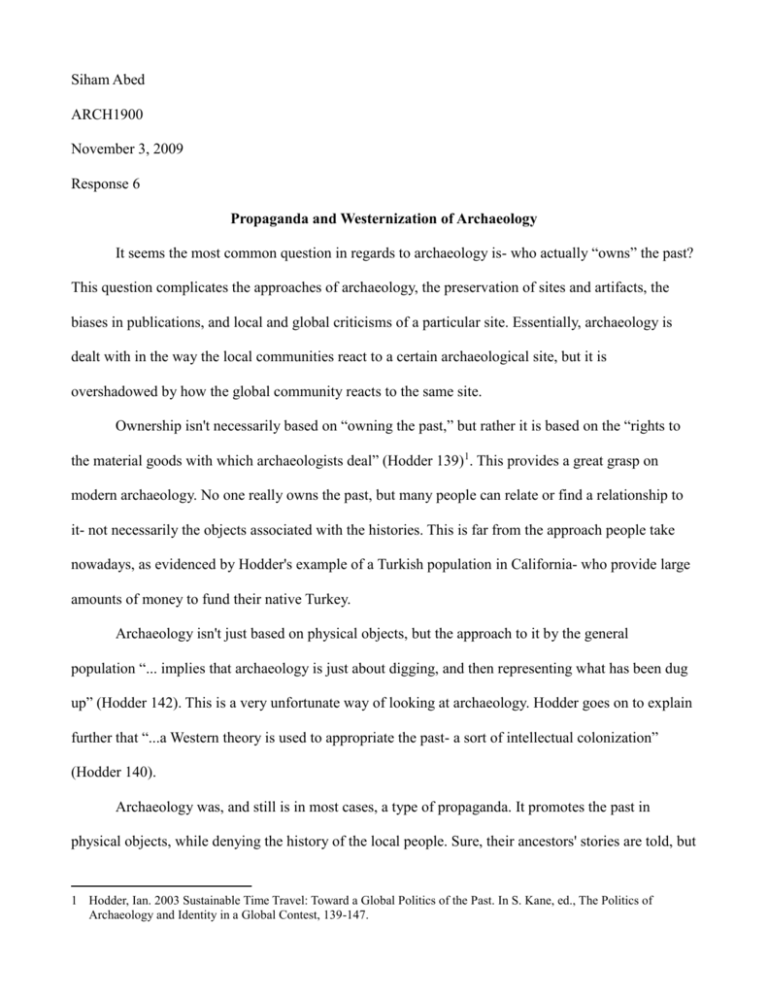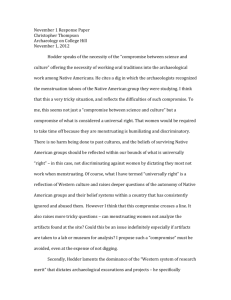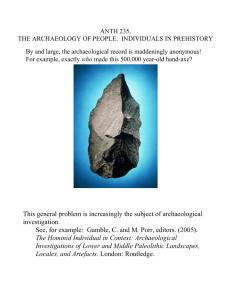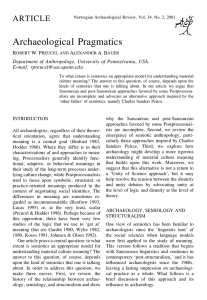Abed6
advertisement

Siham Abed ARCH1900 November 3, 2009 Response 6 Propaganda and Westernization of Archaeology It seems the most common question in regards to archaeology is- who actually “owns” the past? This question complicates the approaches of archaeology, the preservation of sites and artifacts, the biases in publications, and local and global criticisms of a particular site. Essentially, archaeology is dealt with in the way the local communities react to a certain archaeological site, but it is overshadowed by how the global community reacts to the same site. Ownership isn't necessarily based on “owning the past,” but rather it is based on the “rights to the material goods with which archaeologists deal” (Hodder 139)1. This provides a great grasp on modern archaeology. No one really owns the past, but many people can relate or find a relationship to it- not necessarily the objects associated with the histories. This is far from the approach people take nowadays, as evidenced by Hodder's example of a Turkish population in California- who provide large amounts of money to fund their native Turkey. Archaeology isn't just based on physical objects, but the approach to it by the general population “... implies that archaeology is just about digging, and then representing what has been dug up” (Hodder 142). This is a very unfortunate way of looking at archaeology. Hodder goes on to explain further that “...a Western theory is used to appropriate the past- a sort of intellectual colonization” (Hodder 140). Archaeology was, and still is in most cases, a type of propaganda. It promotes the past in physical objects, while denying the history of the local people. Sure, their ancestors' stories are told, but 1 Hodder, Ian. 2003 Sustainable Time Travel: Toward a Global Politics of the Past. In S. Kane, ed., The Politics of Archaeology and Identity in a Global Contest, 139-147. in very much a one-sided way, by people who had no previous ties to the culture. To this day, there is hardly any local connections to archaeological sites. In deciding where to begin projects “there is no evaluation of the impact of the project on local communities.” (Hodder 143). “In many instances, research agendas and methods are still set without local participation and involvement” (Hodder 143). There is a perfect example in the World Heritage Site of the Old Towns of Djenné. As it is currently listed, there are many limitations about what can and cannot be done in and around the site. This site, however, is more than a “snapshot of the past,” it is still a living and breathing community in Mali. Restrictions include the inability to begin a modern day plumbing system, leaving the village in a constant stench. How important is an archaeological site when the local community's health is in danger? “Through the Antiquities Act, Americans accepted that archaeological resources are mainly valuable as sources of information about the past” (McManamon 125)2. This continues the “Westernized” approach to archaeology, as it continues to emphasize physical objects as they pertain to the actual history of the world. Though, in drawing attention to such things archaeology continues its role in propaganda- it can promote nationalism, as it did in early American history. In order to stray away from this westernized approach to archaeology, the local voice must be taken in to consideration, as well as the many tourists, historians, archaeologists, anthropologists, and many others. Silberman argues that most tourist-oriented sites attempt this, but they are merely making an “...appearance of many voices and multiple stories” (Silberman 138)3. This is clear, as these sites with their plaques and attractions are still geared to a certain demographic. Hodder (in Silberman 196) argues against multivocalities in lieu of changing archaeological processes to begin with. This seems to be the best approach to archaeology in the modern world. Allow 2 McManamon, Francis P. 2003 Archaeology, Nationalism, and Ancient America. In S. Kane, ed., The Politics of Archaeology and Identity in a Global Contest, 115-138. 3 Silberman, Neil A. 2008 Virtual Viewpoints: Multivocality in the Marketed Past? In J. Habu, C. Fawcett, and J. Matsunaga, eds, Evaluating Multiple Narratives: Beyond Nationalist, Colonialist, Imperialist Archaeologies. New York: Springer, pgs. 138-143. the locals, anthropologists, historians, and whomever they may be, to engage with the site and the archaeologists from the very beginning. Ask any of those that could be involved about their opinion in regards to a site- is digging going to be more beneficial than merely letting the site be and not disrupting an already told, but possibly hidden, history? The John Brown House represents more than Brown's history, more than Providence's history, and even more than the learning of the student archaeologists who dig there. It represents a global history, adding to the global representation of a land which was once occupied. Much more than my feet have crossed the ground of the John Brown House yard, more than my eyes have seen it. It appears that everyone is a stakeholder, as the John Brown House is a fragment of global history. In writing my final project, I'd like to approach it on more than just a physical level. The yard is more than a place to hold artifacts, it holds a history- a history shared by those of the past and those of the present.









